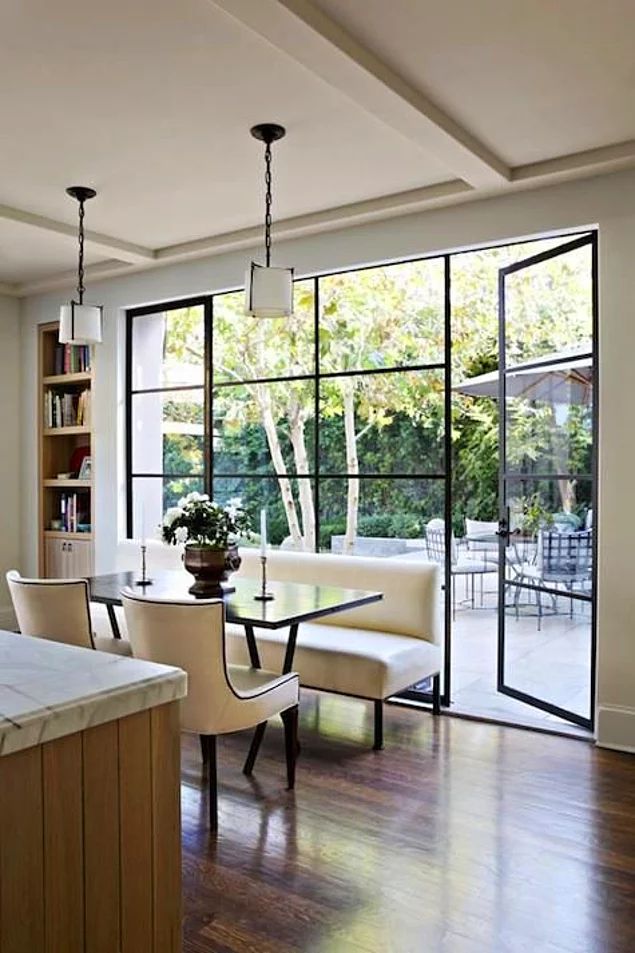Average size of kitchen islands
Standard Kitchen Island Size [Dimensions, Sizes & More]
Top blog articles
Estimate the cost of your kitchen remodel
Estimate the cost of your kitchen remodel
The most useful tool to calculate your home renovation costs for free.
Adding a kitchen island is a great way to increase counter as well as storage space while giving your cooking space a lovely vibe. However, you need to install the right one for your kitchen lest the space looks cluttered and unorganized. Here are some kitchen island size guidelines that you must consider before deciding to get one.
The average size of a kitchen island
The average size of a kitchen island is 80 x 40 inches with 36 to 42 inches of clearance all the way around. The standard height of your island should be 36 inches — raisable up to 42 inches if you are using the island for dining purposes. If you’re thinking of just a breakfast bar — make sure that the barstools have at least two feet of clearance.
Of course, the exact measurement depends on the size and shape of your kitchen. Always check your building codes and kitchen design standards set by the National Kitchen and Bath Association.
Instantly estimate the cost of your remodel...
...or take your time to personalize dozens of choices to transform your house into your dream home.Continue
Island for a small kitchenIn a small kitchen, a huge island will look odd. It will be unsafe, cramped, and awkward. The minimum recommended dimension is about 40 x 40 inches. Such an island though small will give you enough space for your integrated kitchen appliances as well as counter space.
You can install clever accessories such as overhead pendant lights with an extractor — saving you a lot of space while enhancing the look of your kitchen.
Note that if your kitchen is less than 13 feet wide, it’s better to not have a built-in island at all! You can opt for a peninsula instead.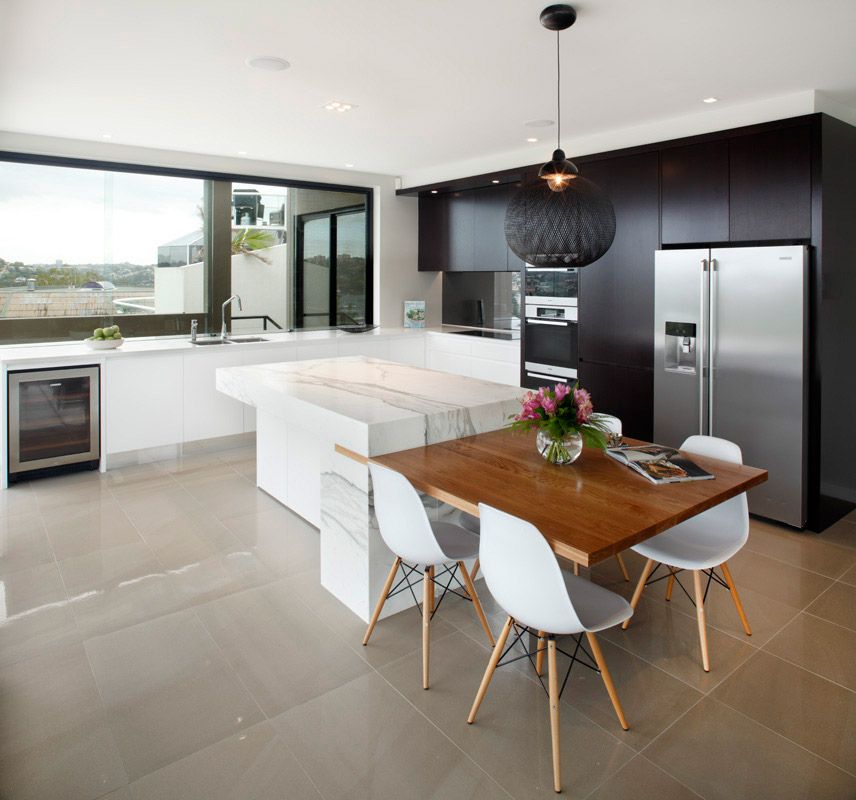 Here, you don’t have to have extra clearance space on the fourth side.
Here, you don’t have to have extra clearance space on the fourth side.
What about butcher blocks, moving islands, and trolleys? These alternatives are not only striking and inexpensive than a fixed island but also offer functionality. Some features include extra storage, workspaces, and mobility.
Read more: Kitchen remodel financing & loan options
Kitchen island size for a galley layoutMany homeowners also opt for a galley kitchen layout because of their comfort levels and ease of use. When this design is well-executed, you can install the island in such a manner so that you have quick, effortless access to all work surfaces, cupboards, and appliances.
Now, if the clearance measures more than 4 feet deep, you might have to travel quite a lot between the island’s workspaces and other areas. This, in turn, shall make your tasks tedious and difficult.
Read more: One wall kitchen layout tips from an expert architect
Right clearance for safety and functionality Photo by Francesca Tosolini on Unsplash CC0When you install an island, the space between the two working areas is termed as the clearance zone.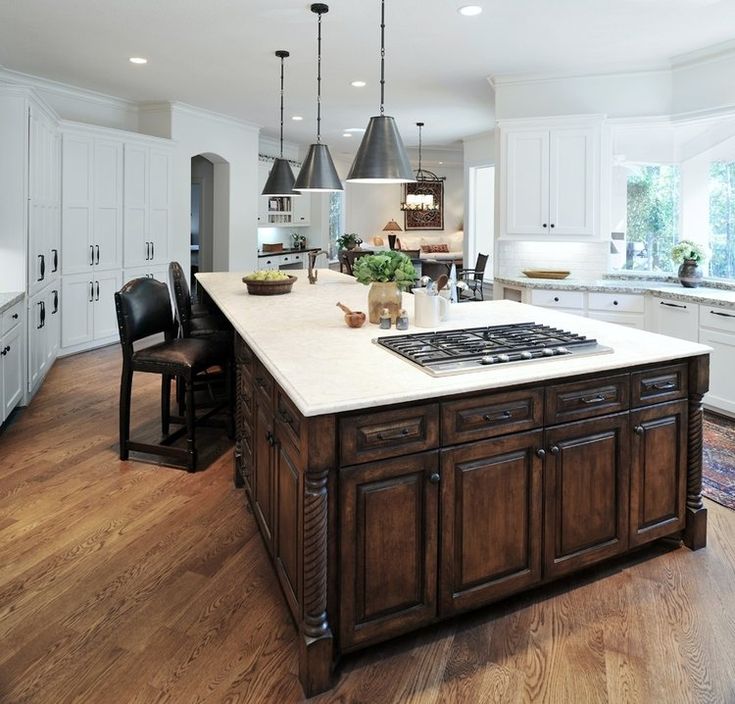 The perfect width of this clearance zone should be approximately 3 feet. Only then, you will be able to move safely and freely within the kitchen.
The perfect width of this clearance zone should be approximately 3 feet. Only then, you will be able to move safely and freely within the kitchen.
The right amount of clearance also determines your levels of safety. You need to check if you can open all the doors, drawers, and ovens easily without any obstruction. If there’s not enough space and the doors are open, you may trip, fall, and hurt yourself.
Note: The minimum allowable distance between two fully extended drawers is 3 feet.
Kitchen island size guidelines and countertop materialYour island size also depends on your worktop material. As most homeowners prefer to create the island top out of a single clean slab of material, this could be a limitation.
Stone worktops such as quartz or granite countertops come in slabs of 3m x 1.4m to 3.2m x 1.5m. If you’re planning an island bigger than 3m, you should be prepared to have joint lines on the worktop. Be aware that this could spoil the look of your island — and your kitchen.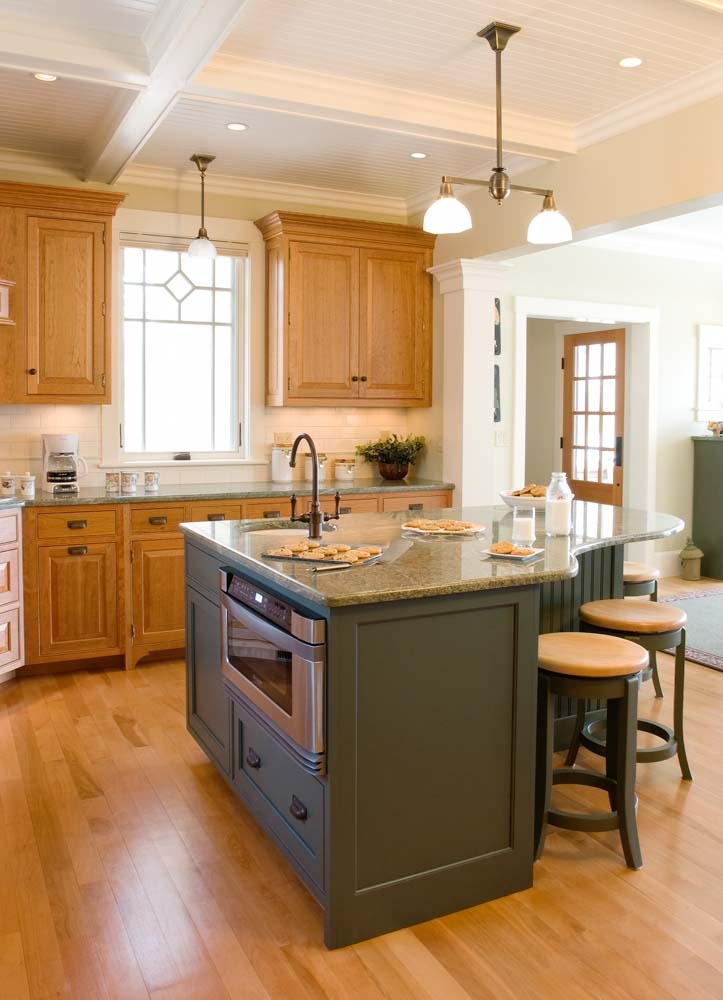
There should be a gap of at least 40 inches or one meter between the countertop/cabinets and the run. This distance ensures easy movement around the island. Moreover, it allows two people to pass each other on the island comfortably. And most importantly, it ensures that all the drawers and cabinets can open easily.
On the other hand, you don’t want too much space between an island and the counter. Such a kitchen will start to look uncoordinated.
It’s also not a practical kitchen layout, in terms of work triangle and efficiency. A kitchen needs to have a fine balance between the island and the walking space.
Overhang for kitchen island seatingAn overhanging countertop on your kitchen island serves as a makeshift table for informal meals and get-togethers. Here too, you need the correct dimensions.
Keep in mind that the minimum overhang for this kind of seating is 20 cm (8 inches) and the maximum is 30 cm (12 inches). The standard measure is about 25 cm or 10 inches. Your island will need legs or L-shaped brackets as supports in case you opt for a deep overhang.
The standard measure is about 25 cm or 10 inches. Your island will need legs or L-shaped brackets as supports in case you opt for a deep overhang.
Your worktop’s thickness proportionally determines the overhang limit. The thicker the countertop, the larger can be the unsupported overhang. Here’s a quick guide for you:
- 12mm thick worktop accommodates 200mm overhang
- 20mm thick worktop accommodates 250mm overhang
- 30mm thick worktop accommodates 300mm overhang
It’s best to hire a professional kitchen designer or consult your worktop supplier for the ideal measurements.
Space per person for seating at a kitchen islandWhen you want to calculate the space for bar stool seating at a kitchen island, a good rule of thumb is allocating 60cm or 24 inches of space per person. This allows enough elbow room to sit comfortably. If your kids are the only people to sit at the island, you may go a little less at 50cm.:no_upscale()/cdn.vox-cdn.com/uploads/chorus_asset/file/19510462/06_dimensions_l.jpg)
When it comes to deciding on the total space for your island — the mantra is quite simple: measure, document, and calculate. Add together all the dimensions we have discussed so far and you will get a good idea on how much space you need to fit an island.
Let’s take an example. Suppose you keep 650mm for your kitchen cabinet depth, 1000mm for walkway space, 900mm for the island (cabinet + overhang), and 1000mm for walkway — it will add up to 3550mm.
This means that you need 3550mm of free space for an island with one run of cabinets in your kitchen. The measure increases to 4200mm approximately for two runs of cabinets.
If in doubt, check with your kitchen contractor. And, don’t be afraid to ask questions.
Final thoughtsIf you wish to install a kitchen island, it should be well-planned so as to lend maximum functionality and comfort to your cooking space. Not only should the island enable proper traffic flow, but it should also offer proper workspace for dining, food prep, and storage.
Not only should the island enable proper traffic flow, but it should also offer proper workspace for dining, food prep, and storage.
An unplanned, improperly sized, and disproportionate island can be frustrating and uncomfortable. You must consider the above kitchen island size guidelines and ensure that you have enough space to go for great kitchen layouts.
Top blog posts
Recommended
How to calculate your kitchen island size according to experts
Real Homes is supported by its audience. When you purchase through links on our site, we may earn an affiliate commission. Here’s why you can trust us.
(Image credit: VERONICA RODRIGUEZ)
Join our newsletter
Thank you for signing up to Realhomes. You will receive a verification email shortly.
There was a problem. Please refresh the page and try again.
By submitting your information you agree to the Terms & Conditions and Privacy Policy and are aged 16 or over.The correct kitchen island size is key if the room is to function as it should and make food preparation and cooking efficient and safe.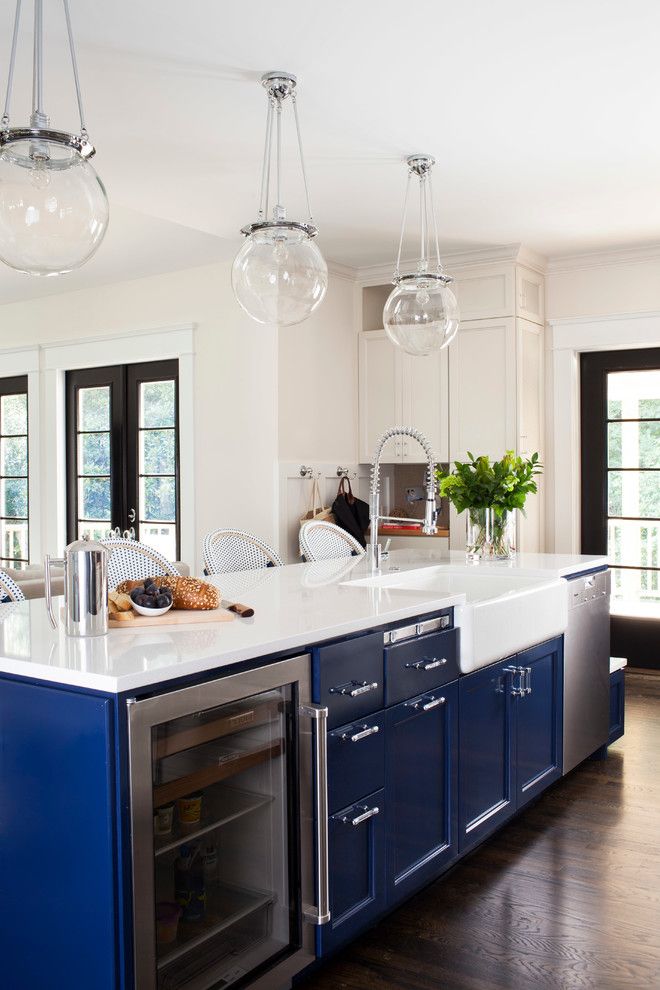 An island that’s too big can impede the flow around the room, or not prove as useful as it should, while one that’s too small can spoil your kitchen's style, and compromise its utility.
An island that’s too big can impede the flow around the room, or not prove as useful as it should, while one that’s too small can spoil your kitchen's style, and compromise its utility.
Your kitchen island ideas might make it an additional working area for the room, a place for the family to eat, or a feature where visitors gather, but whatever functions it fulfills, kitchen island dimensions are crucial to a great remodel.
We’ve asked the experts to share exactly what you need to know about calculating for your kitchen island size to ensure optimum style and function in this very important space.
Kitchen island size: the essentials
If an island is on your list of kitchen ideas, be mindful that it does require a relatively generous space. Is there a standard size you should aim for? The answer is no.
‘There really isn’t a typical island size because you are fitting each island to each particular kitchen keeping in mind the clearances allowed that let people walk around and open cabinets and appliances,’ explains Amber Carfield, lead designer at Scottsdale kitchen remodeler Kitchens by Good Guys . ‘A kitchen island should be custom built so there really isn’t a one-size-fits-all island.’
‘A kitchen island should be custom built so there really isn’t a one-size-fits-all island.’
However, although there isn’t a standard kitchen island size, there is a kitchen island average size and this is 40 by 80 inches (around 1 by 2 metres).
A vital factor in a successful design is the space around the island. ‘I always make sure there’s at least 36 to 48 inches around the island for accessibility and maneuverability around the kitchen,’ says architect Jenn Smith . ‘Anything less and the kitchen won’t function properly.’
Think proportion, too. ‘Kitchen islands should take up between one tenth to one fifteenth of your overall kitchen area,’ says Volodymyr Barabakh, co-founder and project director of Fortress Home . ‘You therefore generally want to err on the smaller side in comparison to your overall kitchen floor space. One fifteenth of your overall kitchen floor space is what you want ideally.’
Can your kitchen be too small for an island? ‘In most cases, you should have a kitchen of at least 150 square foot (14 square meters) to comfortably have an island,’ says Volodymyr Barabakh. Don’t despair if your room is on the small side, though. For more compact rooms small kitchen island ideas can help you get the counter space you’re hankering after.
Don’t despair if your room is on the small side, though. For more compact rooms small kitchen island ideas can help you get the counter space you’re hankering after.
Where to start when planning kitchen island measurements
It’s important here to consider how your island will be used, as well as following kitchen island size guidelines.
‘I always begin the kitchen design process with a series of questions to the client,’ says Barry Schneider, owner of European Kitchen Center . ‘What is your family size? What is your family dynamic? What are your cooking and dining habits? Do you entertain, and how often?
‘The answers determine the kitchen flow and the passage size around the island. Typically, the passage will range from 39 inches (at the minimum) to 48 inches. I use the deduction method, where I subtract cabinet depth and passage length from the total space to deduce the island’s size. This method works well for medium to large kitchen spaces.’
DIYing a kitchen remodel? Plan in outlets. ‘An electrical outlet must be provided every 4 feet, including on an island (with GFCI protection),’ says professional engineer and certified home inspector Mike Powell, owner/trainer at Red Flag Home Inspection . ‘If electrical is not run to the island during the construction activities, it will prove a costly situation to mitigate after construction is complete.’
‘An electrical outlet must be provided every 4 feet, including on an island (with GFCI protection),’ says professional engineer and certified home inspector Mike Powell, owner/trainer at Red Flag Home Inspection . ‘If electrical is not run to the island during the construction activities, it will prove a costly situation to mitigate after construction is complete.’
How big should a kitchen island be?
We’ve talked about the kitchen space, but what else is essential to know about the size of a kitchen island? Elyse Moody, kitchen design expert at Designer Appliances agrees that its proportions depend on the size of your kitchen, but she adds that also important is ‘whether you intend to use your island for prep only or as a seating area.’
As for kitchen island depth if it's to be used as a seating area as well as for other purposes? ‘For the depth, standard cabinets are 24 inches deep, so at a minimum, islands should be 42 to 48 inches deep. This allows for plenty of leg room and creates ample comfort while sitting at the island,’ says architect Jenn Smith
There’s another consideration that’s often missed in thinking about kitchen island size.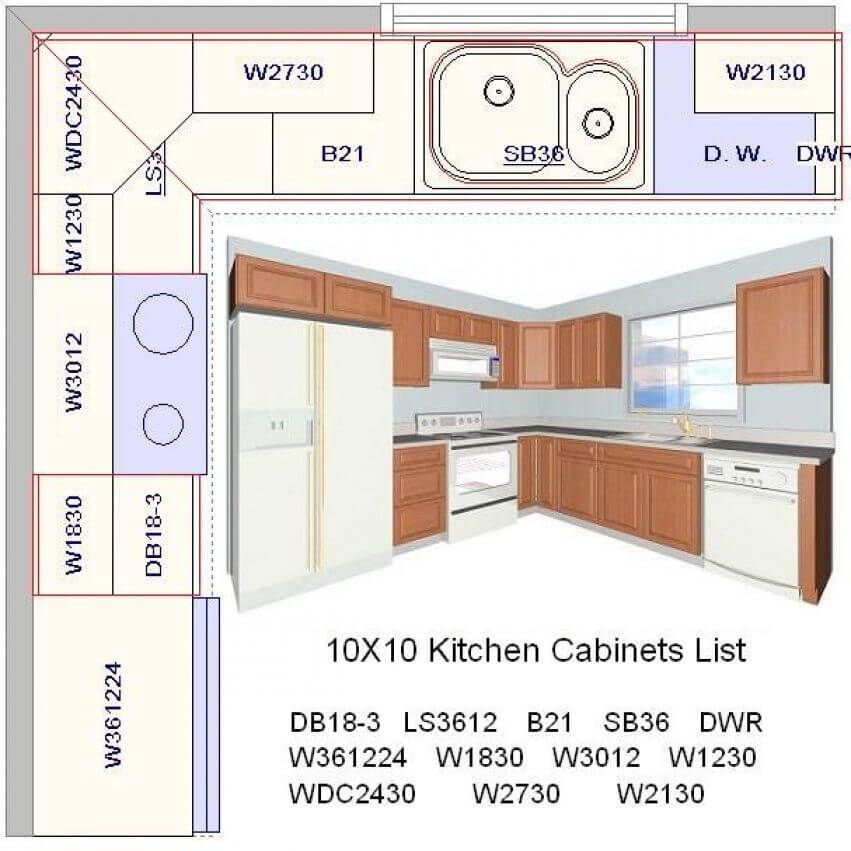 ‘Many people dream of having a large kitchen island, but they fail to consider the maximum size that their countertop material comes in,’ explains architect Mona Ying Reeves, founder of Kickstart House .
‘Many people dream of having a large kitchen island, but they fail to consider the maximum size that their countertop material comes in,’ explains architect Mona Ying Reeves, founder of Kickstart House .
‘Exceeding a standard size or length could add substantial cost to your island. Solid slabs often max out at 8 to 10 feet (2.4 to 3m) depending on the material, and butcher blocks are limited as well due to production and transportation constraints,’ she says.
Combing slabs can also create problems with seams. ‘Depending on the pattern, it may be really obvious where the seam is located and sometimes it’s barely noticeable. It all depends on the countertop color and pattern, plus the skill of the installer,’ explains Jenn Smith.
As we’ve discussed above, a large kitchen island design needs to take into account the slab size available for your chosen kitchen countertop. But if your kitchen is really large, it’s not only the countertop material’s length that should be considered.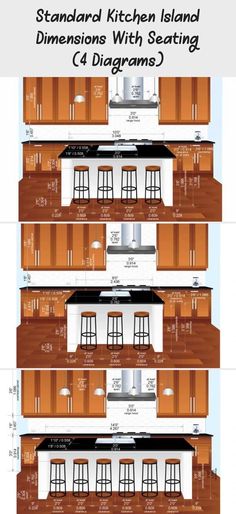
‘Almost any kitchen island will naturally be proportional to the space, as the size is typically dictated by three sides of base and wall cabinets which will determine the length of the center island,’ says Jay Kallos, senior vice president of architecture at Ashton Woods .
‘If you have a really wide space where this guidance isn’t present, your guiding factors are what works aesthetically and ergonomically in the space. This might be an instance where two square islands in line work best by providing access at the midpoint of what would be an island big enough to park a car on without the break. For an extra deep kitchen, two parallel islands work really well, allowing one to be a “working” island and the other left to dining, studying or partying.’
Be sure to think about practicalities as well. ‘Your island shouldn’t be so wide that you can’t reach the center from both sides to clean,’ says Teri Simone, head of design for Nieu Cabinet Doors .
‘For length, it’s important to consider what the island is blocking access to. If the island is so big that you are walking a long way around to access elements of your working triangle, it’s too big.’
If the island is so big that you are walking a long way around to access elements of your working triangle, it’s too big.’
How much space should there be between the island and the counter?
When you’re thinking kitchen island size, the distance between the island and the counter is absolutely crucial.
‘If it’s just an island and you don’t have bar stools on one side, you need to have at least 3 feet (1m) and not more than 4 feet (1.2m) between the island and the surrounding counters or wall,’ recommends Elyse Moody.
‘If you have bar seating that traffic will flow behind, you need at least 4 feet (1.2m) of space behind the stools, between the island and the adjacent counters or walls.’
Mona Ying Reeves agrees: ‘Make sure you leave adequate walking and working room on either side. Local codes will dictate what those minimums are (typically 3 feet (1m)) and it’s good to leave more space (42 to 48 inches (1 to 1.2m)) for working areas where appliance doors open. ’
’
How much overhang should a kitchen island have?
If your kitchen island is used as a seating area, it will need an overhang. ‘A standard counter overhang is 12 inches (30.5cm),’ says Elyse Moody. ‘Whether or not it needs support underneath depends on your countertop material.’
Jay Kallos agrees. ‘A good overhang for eating is 12 inches (30.5cm) but, as with anything, an even deeper overhang is better.’
Ben Neely, owner/president of Riverbend Homes also favors sizing up the overhang. ‘Make sure there is at least 14 inches (35.6cm) of overhang for seating,’ he recommends. ‘This should allow you to fully push any style of barstool in and for the countertop to be comfortably underneath you when eating.’
If your overhang does need support, think about where this is positioned. ‘If the overhang will have braces or corbels, plan their size and location carefully,’ says kitchen and bathroom contractor Jeremy Boulanger of Boulanger Construction . ‘They should be symmetrically spaced and be installed between seats.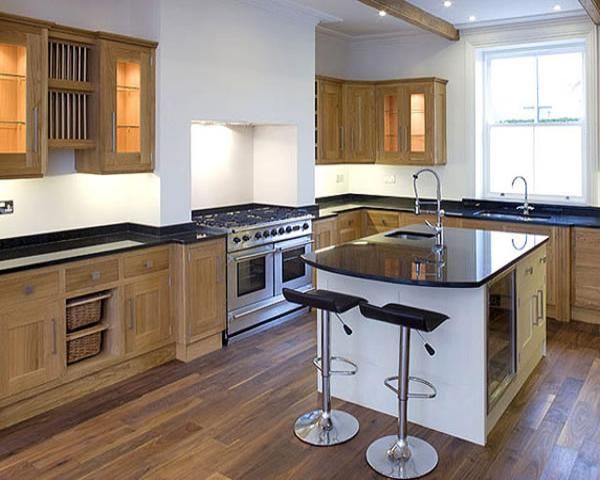 The overhang should extend a few inches past them, so a 16 inch (40.6cm) overhang would have 12 to 14 inch (30.5 to 35.6cm) corbels while a 12 inch (30.5cm) should not have one bigger than 10 inches (25.4cm).‘
The overhang should extend a few inches past them, so a 16 inch (40.6cm) overhang would have 12 to 14 inch (30.5 to 35.6cm) corbels while a 12 inch (30.5cm) should not have one bigger than 10 inches (25.4cm).‘
How much space do you need for seating each person at a kitchen island?
Kitchen island size affects how many people can be comfortably seated at it. After all, everyone needs sufficient elbow room.
‘You should plan on 20 to 24 inches (50 to 60cm) for each person along an island,’ says Jeremy Boulanger. ‘So a 4 foot (1.2m) island would sit two people comfortably, etc.’
Bear in mind that if kids will generally be seated at the island, a width at the smaller end of the range should be just fine.
More space for each person won’t go amiss. ‘Make sure that there is at least 28 inches (71cm) width of space per seat,’ advises Ben Neely. ‘This allows ample space for all your family or guests to sit comfortably together and not be rubbing shoulders.’
The style of your bar stools could mean you need extra space per person. ‘At a minimum, take your stool width and add 6 inches (15cm) for spacing – and that will grow even more if your stools swivel,’ says Jay Kallos.
‘At a minimum, take your stool width and add 6 inches (15cm) for spacing – and that will grow even more if your stools swivel,’ says Jay Kallos.
Don’t forget to plan kitchen island lighting if it’s to be a dining area to make it a cozy place to share food.
How wide is a kitchen island with seating?
The width of a kitchen island with seating will depend on the dimensions of your kitchen and more, and the expert advice above will give you all the numbers you need. However, we recommend that a kitchen island with seating should be at least 36 inches (90cm) wide with the overhang included.
Be mindful of practicalities when it comes to kitchen island size, though. ‘Once the island gets so deep that someone needs to climb up on the countertop to clean it, you have an island that is too big,’ says Jay Kallos.
Sarah is a freelance journalist and editor writing for websites, national newspapers, and magazines. She’s spent most of her journalistic career specialising in homes – long enough to see fridges become smart, decorating fashions embrace both minimalism and maximalism, and interiors that blur the indoor/outdoor link become a must-have. She loves testing the latest home appliances, revealing the trends in furnishings and fittings for every room, and investigating the benefits, costs and practicalities of home improvement. It's no big surprise that she likes to put what she writes about into practice, and is a serial house revamper. For Realhomes.com, Sarah reviews coffee machines and vacuum cleaners, taking them through their paces at home to give us an honest, real life review and comparison of every model.
She loves testing the latest home appliances, revealing the trends in furnishings and fittings for every room, and investigating the benefits, costs and practicalities of home improvement. It's no big surprise that she likes to put what she writes about into practice, and is a serial house revamper. For Realhomes.com, Sarah reviews coffee machines and vacuum cleaners, taking them through their paces at home to give us an honest, real life review and comparison of every model.
Choosing the optimal size of the kitchen island - WikiStroy
kitchen islands can be very different. Most often they are made to order, taking into account the size of the room, the number of people living in the house, the habits and needs of all family members.
The minimum dimensions of a functional kitchen island are 1x1 meter. Such a square design is very compact, but allows, if necessary, to integrate household appliances into the island and conveniently use the countertop. There should be 80 centimeters of free space around such a minimum island for safe passage. Designers admit that such a working area in the center of a small kitchen will not be very convenient for two, and even more so for three. But, if the owners of the island really want it, and the size of the kitchen is small, then there is no other choice.
There should be 80 centimeters of free space around such a minimum island for safe passage. Designers admit that such a working area in the center of a small kitchen will not be very convenient for two, and even more so for three. But, if the owners of the island really want it, and the size of the kitchen is small, then there is no other choice.
The photo shows an example of just such a square island with sides of 1 meter. Anyway, it turned out beautifully and functionally, the distance to other work areas and cabinets was maintained.
The average size of a kitchen island is 1x2 meters. This is already a real workstation, where both washing and hob can be transferred. And there will still be room on the tabletop for work. A space of at least 1 meter wide should be left around such a medium-sized island. This is important for safe passage and movement when two or three people are doing their own business in the kitchen.
Important! It is necessary to take into account the presence of opening cabinets and drawers. If they are both in the island and in the opposite row of the headset, you should leave enough space so that the storage places can be fully opened at the same time. This is especially important if a dishwasher or oven is built into the island itself or in the closet opposite. It is necessary to ensure that they can be used safely and comfortably.
If they are both in the island and in the opposite row of the headset, you should leave enough space so that the storage places can be fully opened at the same time. This is especially important if a dishwasher or oven is built into the island itself or in the closet opposite. It is necessary to ensure that they can be used safely and comfortably.
At the same time, too much distance between the island and the kitchen set is also wrong, the designers are sure. A passage of 1.2 meters is more than enough, even with open cabinet doors. Otherwise, the owners will have to make unnecessary movements, moving between the island, the refrigerator and other areas of the kitchen. Remember ergonomics, it is especially important for the kitchen and home office .
The optimal location of the island in a relatively small kitchen is opposite one row of cabinets. Just one, and not surrounded. In this case, chairs can be placed on the opposite side of the island, turning it into a comfortable dining table.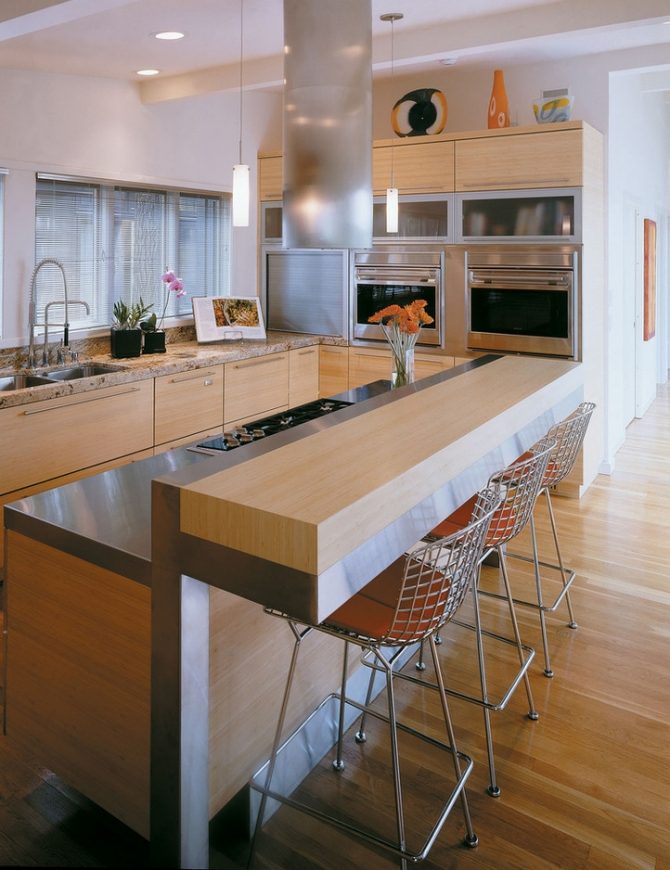 And the owners will be able to work comfortably, rotating between the island and the work area of the headset, without taking extra steps, but simply turning around to transfer something from the countertop to the stove and back.
And the owners will be able to work comfortably, rotating between the island and the work area of the headset, without taking extra steps, but simply turning around to transfer something from the countertop to the stove and back.
It is also necessary to clarify whether the chosen dimensions will allow countertops make it seamless. This is the best option, because the seams will definitely not decorate the countertop. Also, can you carry the countertop into the kitchen, for example, through a winding hallway or a flight of stairs.
Important! The height of the kitchen island should be the same as the bottom row of cabinets, the work surface of the suite.
If your kitchen is really small, don't despair. Even in it you can find a place for homemade minimalist island , the Rmnt.ru portal has already cited such examples.
boring trend or irreplaceable furniture?
First, let's watch a video with examples of what modern kitchens with an island look like:
Advantages of a kitchen island
1.
 Helps to zone the kitchen-living room
Helps to zone the kitchen-living room And if you think that this is a “so-so advantage”, you are mistaken. Euro-planning is no longer a rarity today, and it is not always desirable to build partitions in order to separate the kitchen and living area. The island helps to solve this problem without problems and approvals from the special services.
Photo: Instagram interior_designer_alina
Kitchen island for zoning
2. Convenient for those who cook and do not want to give up the company
Again, relevant for owners of European planning. With a kitchen island, it is convenient to cook food and be “in the know” at the same time: when you come to visit, the family gathers in the living room, or the children play in the same living room. The one who cooks is, as it were, with everyone, is not isolated from what is happening and does not experience boredom.
3. Can be used as an additional work surface
And sometimes it is more convenient than a regular corner or linear kitchen. With a kitchen island, you can create the right working triangle when the cooking (stove), storage (refrigerator) and cleaning (sink) zones are at an equal distance from each other. And even if you do not transfer a stove or sink to the island, you can still cut / put plates of food there.
With a kitchen island, you can create the right working triangle when the cooking (stove), storage (refrigerator) and cleaning (sink) zones are at an equal distance from each other. And even if you do not transfer a stove or sink to the island, you can still cut / put plates of food there.
Photo: Instagram dipmeinchoco
Kitchen island as an additional work surface
4. Suitable for additional storage
The island can be equipped for additional storage of cutlery, crockery and even books, depending on the design of the island and its size. In addition, there you can install additional equipment - a microwave oven or a dishwasher.
Photo: Instagram kitchen_delta
Kitchen island can be used for additional storage
Kitchen island disadvantages
1. Not suitable for small and medium-sized kitchens
You should not even try to implement such a design in Khrushchev and Brezhnevka kitchens.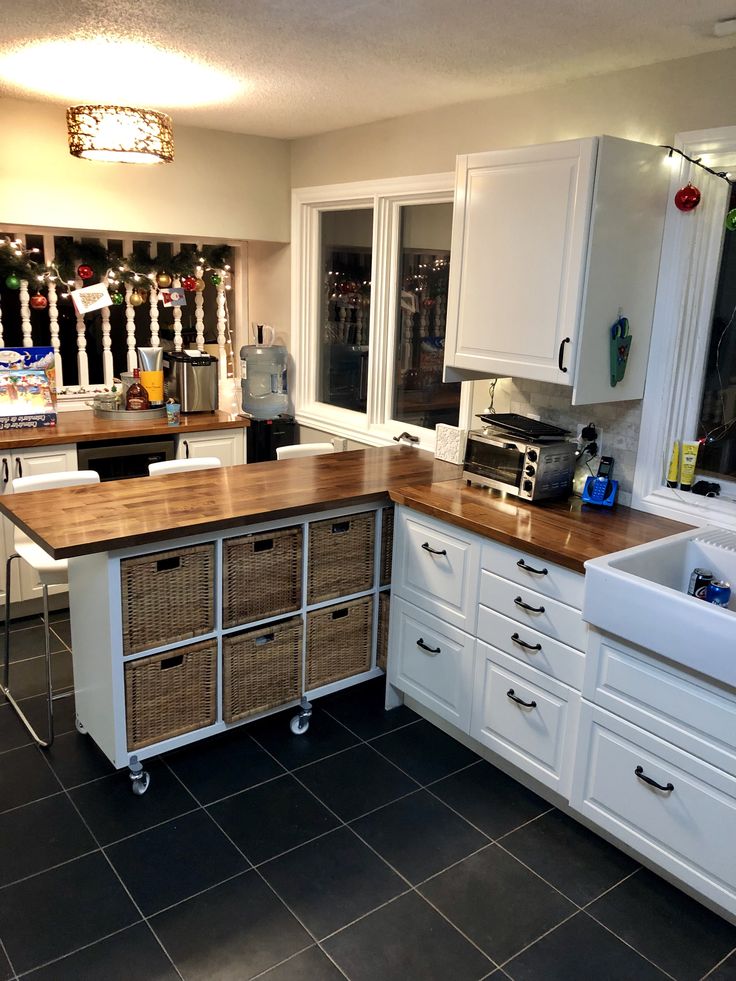 Yes, and in average kitchens with a footage of 10-12 squares - too. It turns out that the island is available only for overall kitchen-living rooms in apartments and houses. That certainly doesn't make it universal.
Yes, and in average kitchens with a footage of 10-12 squares - too. It turns out that the island is available only for overall kitchen-living rooms in apartments and houses. That certainly doesn't make it universal.
Photo: Instagram Buro7art
Kitchen island definitely not suitable for small kitchens
2. Will not replace a dining table
By the way, a common mistake of those who have long dreamed of a kitchen island is to turn it into a dining table in a small kitchen. No, it won't work. It will partially replace the place of eating, but not completely. You can replace the table with them if you live alone / alone or together and do not receive guests. And you are not planning children and do not expect elderly parents to visit. Neither one nor the other will be able to sit on high bar stools for a long time.
If you have a large apartment and have a dining area, you can put chairs in the kitchen near the island and use it, for example, for morning coffee or quick breakfasts.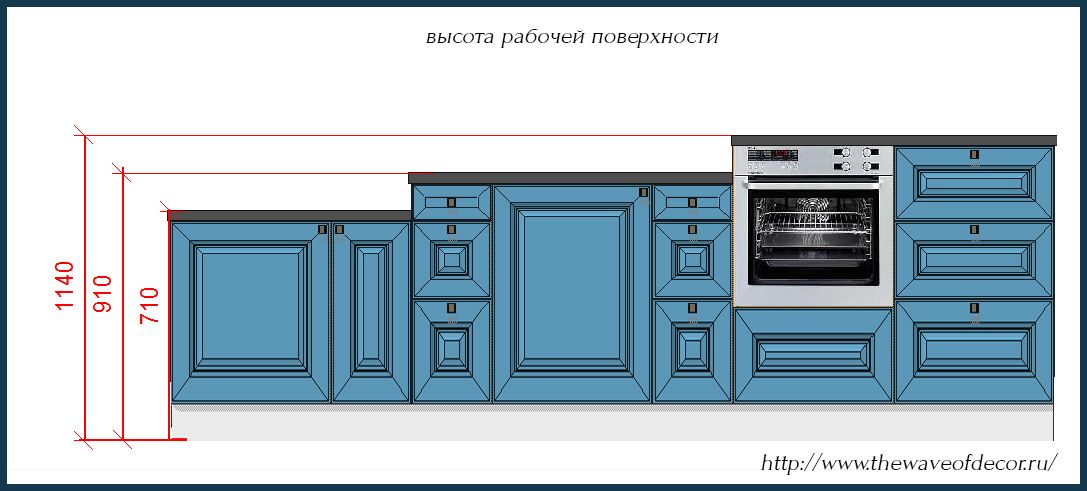
Photo: Instagram ikea_inst
The kitchen island will not replace the dining table, but you can use it instead of the bar counter
3. May require additional approvals from housing services
It will be required if you decide to move the "wet" area to the island - sink and dishwasher. Firstly, you will have to drain, which means “raising” the floor level by at least 10-15 cm. Secondly, such a transfer somehow requires permission from special services.
When is an island really appropriate?
1. If the kitchen is at least 18-20 sq. m.
Or is it the total area of the kitchen-living room. As a rule, the dimensions of the average island are 120 cm long, 60 cm wide, and 85 cm high. Agree, for such dimensions you need to find a place, and at the same time leave free passages. An island in a small kitchen will visually make it even smaller and add inconvenience.
Photo: Instagram soldatova_interior
A kitchen island can only be placed in a spacious kitchen or kitchen-living room
2.
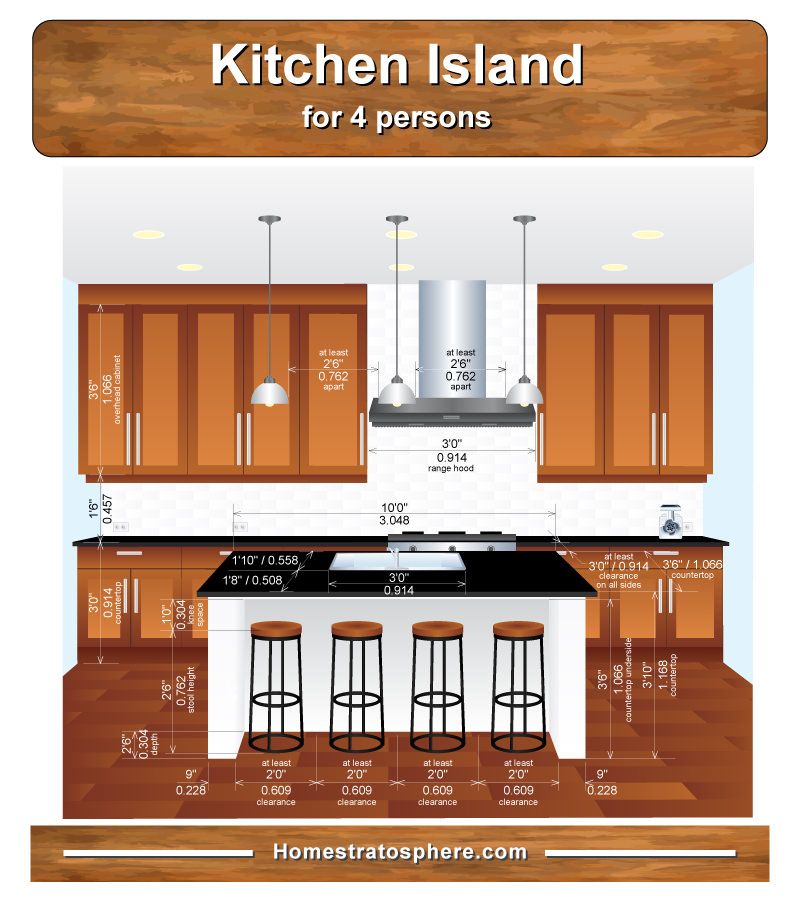 If it brings real benefits
If it brings real benefits We agreed that using it instead of a table or a bar is not a good idea. But to place additional equipment there, a hob or a sink is really functional.
Photo: Instagram nashamarka
Kitchen island as an additional work surface
3. If it helps to create the right work triangle
If placing appliances or a sink on an island makes cooking and moving around in the kitchen more convenient, it really makes sense.
Photo: Instagram planaspb_com
A kitchen island will help you make the right work triangle
What's the result?
We cannot call a kitchen island indispensable. You can really do without it: find other ways of zoning, make cabinets up to the ceiling to find more storage space and, in the end, work on the ergonomics of the kitchen for the right “working triangle”.

